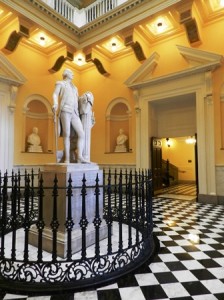Archive for March 15th, 2013
» posted on Friday, March 15th, 2013 by Linda Lou Burton
Sophisticated Simplicity
 Linda Burton posting from Richmond, Virginia – If you want to know what George Washington really looked like, go to the Virginia state capitol. Centered in the rotunda against the simplicity of a formal backdrop of black and white stands a life-size statue of Washington, considered by his contemporaries to be “a perfect likeness.” It was June 1784 when the Virginia General Assembly commissioned the statue to be made; Thomas Jefferson, on a diplomatic mission in France, secured the services of French artist Jean-Antoine Houdon for the work. Houdon didn’t guess at his task; in the fall of 1785 he traveled to Mount Vernon to study his subject. He made a plaster mask of Washington’s head and took detailed measurements of his body; from this he modeled a terra cotta bust to take back to his workshop in France.
Linda Burton posting from Richmond, Virginia – If you want to know what George Washington really looked like, go to the Virginia state capitol. Centered in the rotunda against the simplicity of a formal backdrop of black and white stands a life-size statue of Washington, considered by his contemporaries to be “a perfect likeness.” It was June 1784 when the Virginia General Assembly commissioned the statue to be made; Thomas Jefferson, on a diplomatic mission in France, secured the services of French artist Jean-Antoine Houdon for the work. Houdon didn’t guess at his task; in the fall of 1785 he traveled to Mount Vernon to study his subject. He made a plaster mask of Washington’s head and took detailed measurements of his body; from this he modeled a terra cotta bust to take back to his workshop in France.  The resulting statue, carved of Carrara marble, was shipped to America in 1796 and has graced the capitol’s rotunda since. It is considered to be Virginia’s greatest treasure and one of the world’s finest portrait sculptures; it is the only full-length statue for which the first President posed. Although Washington’s sword is by his side and he wears his Revolutionary uniform, he
The resulting statue, carved of Carrara marble, was shipped to America in 1796 and has graced the capitol’s rotunda since. It is considered to be Virginia’s greatest treasure and one of the world’s finest portrait sculptures; it is the only full-length statue for which the first President posed. Although Washington’s sword is by his side and he wears his Revolutionary uniform, he  carries a civilian walking cane and stands over a plough; Houdon sought to show the balance between Washington’s life as a soldier, statesman, and private citizen. In the niches of the rotunda are busts of other Virginia-born presidents who succeeded Washington – Jefferson, Madison, Monroe, Harrison, Tyler, Taylor, and Wilson – and another work by Houdon; that of LaFayette, the French citizen who was a Major General in service to the United States during the Revolutionary War. But more about the rotunda itself, a magnificent two-story space capped by a dome; a dome that is invisible from the outside. » read more
carries a civilian walking cane and stands over a plough; Houdon sought to show the balance between Washington’s life as a soldier, statesman, and private citizen. In the niches of the rotunda are busts of other Virginia-born presidents who succeeded Washington – Jefferson, Madison, Monroe, Harrison, Tyler, Taylor, and Wilson – and another work by Houdon; that of LaFayette, the French citizen who was a Major General in service to the United States during the Revolutionary War. But more about the rotunda itself, a magnificent two-story space capped by a dome; a dome that is invisible from the outside. » read more
